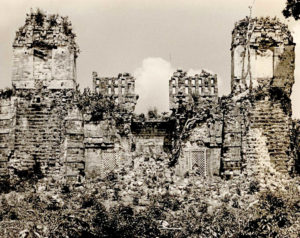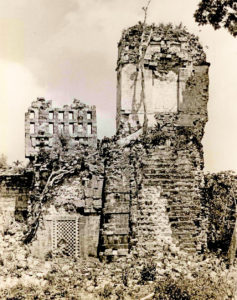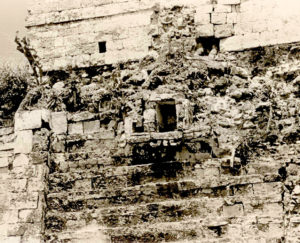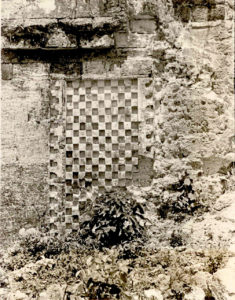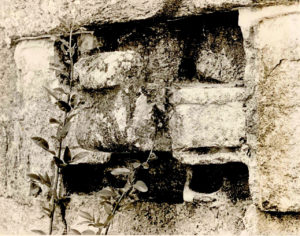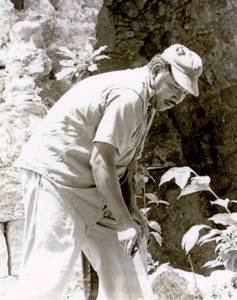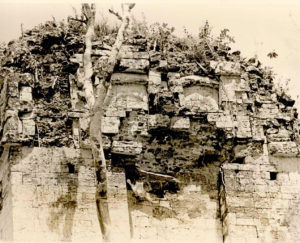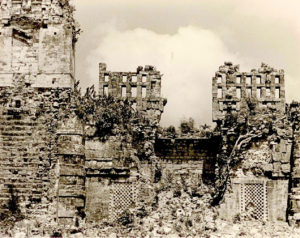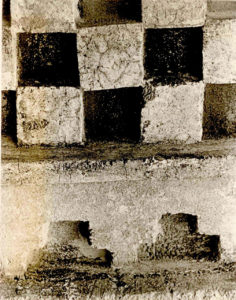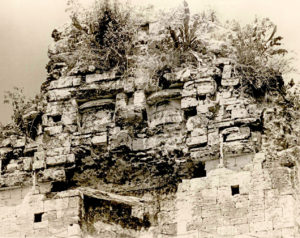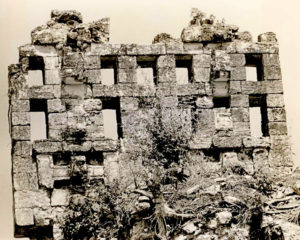Rio Bec: Visit to a Twice Lost Mayan Temple
By Joyce Kelly
Rio Bec:
Rio – Spanish for river; Bec – Mayan for evergreen oak
It seems almost inconceivable that in our scientifically and technologically advanced twentieth century a large Mayan temple could be discovered, beautifully photographed, mapped and then lost again for better than half a century. But this is the true story of Rio Bec B.
Many Mayan sites were lost to man’s knowledge from the time of their virtual abandonment at the end of the 10th century until their discovery by westerners in the 16th through 20th centuries. But Rio Bec B has the distinction of being lost twice. For 61 years it lay hidden from the eyes of man in the dense jungle undergrowth of southern Campeche almost on the border of Quintana Roo at the base of the Yucatan Peninsula.
One of the early explorers of the Rio Bec area was Maurice dePerigny who in 1908 discovered an ancient ruined temple of unusual design. He named it Rio Beque after a small nearby stream. In 1912 another expedition to the area was sponsored by the Peabody Museum of Harvard University under the direction of archaeologist Dr. R.E. Merwin and his assistant Clarence L. Hay.
Merwin and Hay relocated the site discovered by dePerigny and discovered another a short distance away. The new discovery was in a much better state of preservation but in the same unusual style of two tall towers with non-functional temples on the top joined by a lower range of rooms. It differed markedly from the well-known Peten style found to the south in Guatemala and from the Puuc style to the north in the Mexican states of Yucatan and northern Campeche. The discovery, therefore, of a “new” style geographically located between the other two stirred quite a bit of interest in archaeological circles.
To distinguish the two Rio Becs, dePerigny’s site was called Rio Bec A and the one discovered by Merwin and Hay was named Rio Bec B.
Temple B was cleared of its jungle vegetation and was carefully and exquisitely photographed by Clarence L. Hay. One classic shot has been published in many books on pre-Columbian archaeology and a model of the reconstruction of the temple was produced from the photos and Merwin’s field notes.
A number of other expeditions were sent to the area over the years and they were always able to relocate Rio Bec A. Additional ruins were also discovered but Rio Bec B could not be found.
How tantalizing to read about the area and see photos of Temple B and realize that no one knew where it was.
For us inveterate ruin buffs – – not to mention the archaeological world in general – – the rediscovery of Rio Bec B was indeed exciting news even though we knew nothing of the details. Word came to us at exactly the time my husband Jerry and I were planning a trip to that general area to visit some other Mayan sites. Needless to say we put Rio Bec B at the top of our priority list.
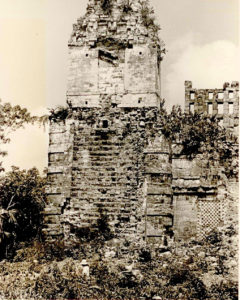
Detail of the right tower of Temple B at Rio Bec showing the “false” steps leading up to the “temple” on top.
We first learned of the rediscovery of Rio Bec G through our fellow New Orleanians and Mayan enthusiasts, Taylor and Ellie Caffery, who got word of it from Dr. E. Wyllys Andrews V of the Middle American Research Institute of Tulane University (MARI), with whom and whose family they are longtime friends.
The Cafferys had recently visited the area but, unfortunately, were unable to get to Rio Bec because they located the guide too late in the day. Happily for us, they had information on how we might go about arranging to see it. Their directions were, “Pick up Juan at Becan at 7 in the morning, and he may be able to take you.”
With this as our ONLY information we decided to try it. We were, of course, especially conscious of the need to arrive early.
There aren’t many things that I think are worth getting up for at 4:45 am but a possible visit to a twice-lost Mayan temple is one of them. We had spent the night at Chetumal some 85 miles from the ruins of Becan where we were to pick up Juan de la Cruz Briceno who is the caretaker or “guardian’ there. So, after arising before the crack of dawn, and making a short stop in Chetumal to pick up ice and soft drinks, we headed toward Becan at 5:55 am feeling fairly confident that we would make it by 7:00 am.
Breakfast was half of a left-over box lunch from the day before and some cheese crackers which we ate while driving. A great deal of mist on the highway slowed us up some but not enough to seriously disrupt our intended schedule.
Then some 25 miles out from Chetumal we ran into a situation that we thought meant the end of our hopes of seeing Rio Bec. We came across an unexpected Aduana (customs and immigration) station and they flagged us over. My heart sank! I knew they only wanted to check our tourist cards, but those were back in Chetumal in our luggage. I explained this in my very best Spanish – which isn’t too great – to the official at the station.
He insisted that it was impossible for us to proceed without presenting our cards and suggested that we return to Chetumal to get them We were already running a little late and returning to Chetumal for the cards would have lost us another hour or so meaning that we couldn’t get to Becan before 8:30 or 9:00 am, effectively ruining our chances for a trip to Rio Bec. I wasn’t about to give up that easily.
A second official was called in and I re-explained the situation to him, emphasizing the necessity of our getting to Becan by 7:00 am and further explaining that since we were only going to visit some ruins for half a day and would be retuning in the afternoon, couldn’t he please, please let us through. After a bit more conversation and pleading on my part and a quick inspection of our car and its contents on their part, they relented and with a shrug of their shoulders, they waved us off with a smile. At most we lost five minutes.
We arrived at Becan only 20 minutes late and asked some people on the highway where we might find Juan. Their directions indicated a narrow trail which led to his house a half mile off the highway near the archaeological zone. When we arrived we saw a man who we correctly assumed was Juan and told him that our friends, the Cafferys, had told us about him and suggested that he may be able to take us to Rio Bec. He paused a moment, looked over out rented Volkswagen bug – which was half covered by weeds- and declared that he thought possibly we could make it. There was no question of his being willing to take us especially when he learned that we knew one of the sons of the late Dr. Andrews IV of Tulane University. Juan said proudly that he had worked for the elder Dr. Andrews. He obviously held him in high-esteem. It was rather like old home week.
Juan went into his house to sharpen his machete and get a hat and with no more ado, we were ready to go! It turned out to be much simpler than we had expected and it still amazes me that we could simply show up and get everything arranged for the trip on the spot.
We drove back along the highway for a few miles to Xpuhil and then turned south on a very rough, rutted and sometimes slippery dirt road. We chatted with Juan between skids and jolts of the car and learned, among other things, that we were in the presence of the man who was the chief guide in the party responsible for the rediscovery of Rio Bec B. He was very proud of the fact and I couldn’t blame him.
As we drove I recounted the little that I knew of Rio Bec, mainly that the Rio Bec style dated to the Late Classic Period of Mayan chronology, and more specifically – I learned later – to the period between AD 75- to AD 850 or 900. From two newspaper clippings and talks with archaeologists I was later able to piece together the details of the rediscovery.
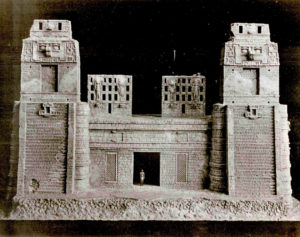
Model of Temple B at Rio Bec, reconstruction. Built be Shoichi Tchikawa. Courtesy of the American Museum of Natural History.
In 1971, Hugh and Suzanne Johnston visited the area and were shown around and oriented by Jack Eaton of the Middle American Research Institute’s field staff. While working for MARI with the sponsorship of the National Geographic Society, Eaton and others had methodically cut a grid system through a large part of the area in search of ruins. Several were discovered and publication of their data will be forthcoming. It later developed that one of the MARI’s trails stopped just a stone’s throw short of the elusive Temple B.
The Johnstons, a documentary film team from Princeton who were engaged by WNET/13 to do a film on “The Mystery of the Maya” for television viewing, returned to the area in 1972 and 1973. On their third trip they were accompanied by Gillet G. Griffin, pre-Columbian Art historian at Princeton University. In between trips they had studied the field notes of Dr. Merwin and drew their own map from his data.
With this preliminary work, the aid of workmen in the area and with Juan as their guide they rediscovered Rio Be B in May of 1972. A truly exciting find for the world of archaeology!
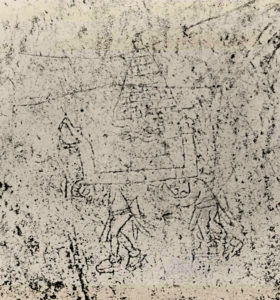
Graffito of two men carrying a litter made of a rattlesnake with “personage” riding in it and a temple pyramid in the background. Located on the interior wall of Temple B at Rio Bec.
At this point after bumping along that terrible road for three quarters of an hour, we came across a young man with a horse and Juan indicated that we should stop as he was the “guardian” of Rio Bec. They chatted a while and again our hopes were almost dashed.
The guardian said that the last 12 to 15 kilometers of the road were impassable – very wet- underwater almost. The part we had already traveled although rough was certainly passable. I wasn’t looking forward to something worse. It felt like we’d already traveled well over the 32 kilometers mentioned as the total distance we’d go by car. We were about to turn around as the guardian left but Juan was not inclined to quit. After all, he didn’t get to guide people to Rio Bec every day. He suggested that we keep going and if the road really became impassable, we could turn around then.
A few kilometers and we turned off onto a side road that was really nothing more than a trail. A few kilometers more and we turned off that onto something indescribable! For the sake of calling it something, I’ll call it a track but in many spots it wasn’t even visible. The jungle vegetation at the edge and in the center of the track almost swallowed the car. It was like driving through a tunnel. I was hoping at this point that we had already passed the “impassable” section and that we wouldn’t have to turn around as I didn’t see how we possibly could.
Juan was apparently satisfied that we wouldn’t have to retreat and commented rather smugly that the guardian of Rio Bed didn’t really know what he was talking about and that we – with Juan’s guidance – certainly could make it. I got the impression that Juan wasn’t about to let us turn around even if we had wanted to. It was getting to be a real “macho” thing. Nevertheless, I appreciated Juan’s confidence, as mine was beginning to wane.
We made a stop – unfortunately not the last one – necessitated by a small tree lying across the track. Juan got out and in a couple of minutes chopped it away with his machete. I was glad for even a short break in the driving. I kept hoping that surely we must have come 32 kilometers by now.
A few minutes later and we finally arrived at our stopping point. This was an unbelievable relief. It was marked only be a slight widening in the track which continued on. From here we would have to walk an additional three kilometers through the jungle. In preparation I donned my jungle foot gear consisting of heavy socks and climbing boots. We all had a soft drink and Jerry and I applied insect repellent. It was just two hours since we had picked up Juan at Beca. It seemed much longer.
At this point our excitement mounted and we began to believe that we really would get to see Rio Bec. Memory of the bone-shattering drive quickly faded.
With Juan in the lead, me in second place and Jerry in the rear, we began our trek on foot. For a while at least, it was a relief not to be bumping along on a bad road. Juan stopped briefly after we had been walking only a short while and looked around. For a moment I wondered I he was certain about which way to go. The path was scarcely visible to me most of the time but it was clear to him; at least I hoped so. The idea of getting lost in the jungle was not particularly appealing. But Juan, a former Chiclero, is one of the best bush men in the business and we needn’t have worried.
We clambered over rocks and fallen trees as Juan hacked the way with his trusty machete. Hot – – steamy – – no breeze because of the dense vegetation. I began to see how Rio Bec could have been lost twice; you could see no further than twenty feet in the clearer spots.
Thirty minutes after we began our walk, we arrived at the marvelously well-preserved Temple B, a truly exciting sight! We’d made it. And it was worth it. So many ruins are simply rubble heaps until they are excavated and restored, but here is one that has only been cleared of its jungle vegetation yet is, for the most part, intact.
Its twin towers still soar to their original 55 feet; its two stone roof trellises retain most of the decorative masks as they were designed. Unhappily most of the stucco figures are gone but considering its respectable age of over a thousand years, I suppose one shouldn’t complain. Some of the corbeled vaults supporting the roof over the six rooms have collapsed but essentially the feeling of the whole is preserved. When you look at it you know exactly how some Mayan architect wanted it to look when he designed it.
We stood before this fantasy in stone and stucco and contemplated it with awe. This rarely seen gem of world art sat in the brilliant sunlight, its small clearing encircled by the green of towering trees and trailing vines. How incredible that it should be here at all or that any human should have conceived or built it. And what of those who died? How little do we really know of their thought or motivation? Yet, surely they would be pleased that strangers found their work fascinating and impressive. Yes, the trip was really worth it. We ruin buffs do get our rewards.
After regaining some measure of composure we began the task of photographing Temple B and exploring it throughout. We climbed to the roof trellises up some rubble on the back side. The steps of the towers are “false steps” that were never meant to be climbed. They seem purely decorative but most likely were incorporated in the design in imitation of the earlier temple-pyramids found to the south in the Peten of Guatemala.
We investigated the interior of the rubble filled rooms and found that much of the plaster was in good repair. Many bits of interesting graffiti are clearly discernible. One, dubbed “the Botticelli Nude” by Hugh Johnston, is quite contemporary in feeling and is of dubious antiquity. Dr. E. Wyllys Andrews V feels that it was probably drawn during the last century, as a nude female torso is totally out of keeping with the precepts of Classic Maya Art. Other graffiti are more in keeping with the perhaps symbolic ones found at other Mayan sites – temples, processions and typical if rather crude Mayan profiles. Juan made sure we didn’t miss any.
For the most part, however, he left us to our own devices while he relaxed. That is, he relaxed until he discovered a “garrapata”, a tiny tick which is the bane of archaeologists and travelers in the area. He then asked for some of our insect repellent which he had previously declined.
By this time we had rather thoroughly explored Temple B and we regretfully decided to depart.
We traveled the same trail with its heat and humidity, and the rocks to be climbed, and the same thorn bush clawed at us but somehow it didn’t seem as difficult or as long on the way back. The jungle seemed almost friendly and we arrived back at the car in high spirits though tired and thirsty.
After a short rest and a long and much needed cold drink, we began our drive. A few minutes later, Juan indicated a stop and told us that just 3 kilometers away on foot was another ruin, Temple J, and he asked if we wanted to see it. We were torn between wanting to and exhaustion and considered the fact that there were five other sites we planned to visit that day including Juan’s Becan. We deliberated a moment before answering.
“No, not this time. But perhaps next year we’ll come back and then you can take us to Temple J.”
And who knows what other ruins Juan may have tucked away.

